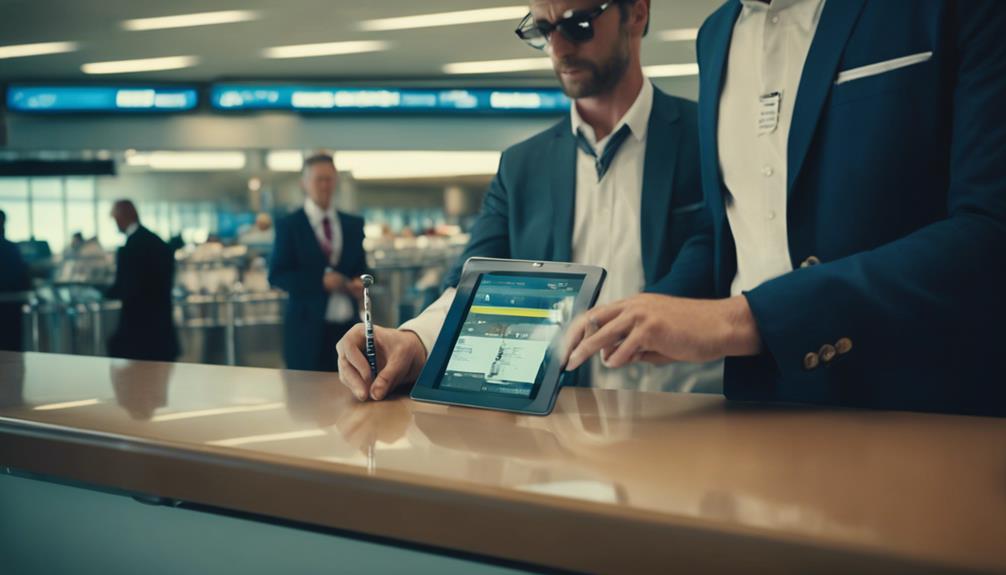- 7 Top Flite Golf Clubs XL for Improved Performance - September 28, 2024
- Top Flite Golf Clubs: Top 5 Reasons to Choose Them - September 28, 2024
- Top 3 Golf Club Fitters for a Perfect Swing - September 28, 2024
You're ready to hit the links, but first, you need to get your golf clubs on the plane! Almost every airline treats golf clubs as standard luggage, so they'll need to be checked. Before booking your ticket, check with the airline to avoid any surprises. Pack your clubs carefully to prevent damage, and make sure they meet the airline's weight and size requirements. Weigh your bag ahead of time to avoid overweight fees. Now that you've got the basics down, you're ready to take your game to new heights – and learn more about making your golf trip a success!
Key Takeaways
- Check with the airline beforehand to understand their golf club policy and avoid unexpected fees or restrictions.
- Pack golf clubs carefully in a hard-shell case with towels and clothing to prevent damage during transit.
- Weigh the golf bag ahead of time to avoid overweight fees, as most airlines have a 50-pound weight limit.
- Consider shipping golf clubs with a service like FedEx or Ship Sticks as a viable alternative to airline travel.
- Research and understand the airline's policies on golf club size and weight restrictions to ensure a smooth journey.
Golf Club Air Travel Basics
When you're planning to bring your golf clubs on a plane, you must know the basics of golf club air travel to avoid any unexpected hassles or fees.
To start with, understanding that almost every airline treats golf clubs as standard luggage is vital, which means they'll be checked luggage, not carry-on.
You should also be aware that airlines' policies on golf clubs vary, so it's imperative to check with your airline before booking a ticket to have a smooth trip.
As checked luggage, golf bags aren't charged extra fees as long as they meet the standard weight and size requirements.
However, if your bag is overweight, you'll face costly fees.
To avoid this, make sure to weigh your bag ahead of time and be prepared for additional screening procedures.
Remember, the TSA officer at the gate has the final say on whether to allow your golf bag through.
Packing and Protecting Your Clubs
Now that you've got the basics of golf club air travel down, it's time to focus on the nitty-gritty of packing and protecting your precious clubs, which can make all the difference between arriving at your destination ready to play and facing a costly repair bill.
To safeguard your golf clubs' arrival in pristine condition, packing them carefully is crucial.
Wrap towels and clothing around exposed clubs to prevent damage, and consider using a protective umbrella device to safeguard drivers.
Limit the number of golf balls you pack to avoid overweight bag fees, and use the extra storage space in your golf bag for accessories and shoes.
Pack your golf clubs in a way that distributes weight evenly, and avoid packing fragile items near the clubs to prevent breakage during transit.
Investing in a high-quality travel bag with padding can provide added protection for your golf clubs.
You can also use a stick or broomstick to add vertical strength to your travel bag.
Understanding Airline Policies

When you're getting ready to fly with your golf clubs, verifying the airline's policies on golf equipment is crucial.
You'll want to check their rules on transporting golf clubs, as well as the baggage allowances, to avoid being hit with unexpected fees or hassles at check-in.
Airline Golf Club Rules
As you prepare to take your golf clubs on a plane, you must research and understand the varying airline policies that govern the transportation of your precious golf gear.
Most airlines treat golf clubs as standard luggage with a weight limit, usually 50 pounds, but no oversize baggage fee.
However, you should be aware that each airline has its own set of rules and regulations.
Some airlines, like American Airlines, permit clubs, balls, tees, and one pair of golf shoes in golf bags, while others have different policies for golf clubs.
Airlines may ask to open golf bags at the airport to check for approved items, and failure to comply with airline policies may result in fees.
Direct flights can reduce the risk of missing connections and lost golf clubs, as golf clubs are among the most likely items to be left behind on tight connections.
Golf Baggage Allowances
You'll want to familiarize yourself with each airline's golf baggage allowances, which can vary substantially, even if most treat golf clubs as standard luggage with a weight limit of usually 50 pounds, but no oversize baggage fee. Understanding these policies will guarantee a smooth trip and avoid any surprises at the airport.
Here's a breakdown of some popular airlines' golf baggage allowances:
| Airline | Weight Limit | Additional Items Allowed |
|---|---|---|
| American Airlines | 50 pounds | Clubs, balls, tees, one pair of golf shoes |
| Delta Air Lines | 50 pounds | Clubs, balls, tees |
| United Airlines | 50 pounds | Clubs, balls, tees |
| Southwest Airlines | 50 pounds | Clubs, balls, tees |
| JetBlue Airways | 50 pounds | Clubs, balls, tees |
Fees and Extra Costs Involved
One thing to keep in mind when traveling with your golf clubs is that most airlines won't charge you extra fees as long as your clubs meet their standard weight and size requirements. However, be aware of the fine print and weight limit to avoid any surprises.
Overweight fees can add up quickly, so make sure to weigh your bag ahead of time to avoid additional charges.
Some airlines allow golf bags as carry-on luggage, but only if they weigh less than 50 pounds, so check with the airline before booking a ticket to confirm their policy.
Not all airlines compensate for damage, so research and understand the airline's policies before flying to minimize risks.
Tips for a Smooth Journey

To guarantee a hassle-free trip with your golf clubs, planning ahead and researching airline policies on golf club size and weight restrictions before booking a ticket is vital. This will make you aware of any specific requirements or limitations, allowing you to prepare accordingly.
Consider shipping your golf clubs with a service like FedEx or Ship Sticks as a viable alternative to airline travel to eliminate the risk of airline mishandling.
When packing, treat golf clubs with care by using a high-quality travel bag with padding to provide added protection during transit. You can also pack essential items like a golf jacket and extra clothing in the golf bag to avoid last-minute hassles and stress.
Additionally, opt for direct flights to reduce the risk of missing connections and lost golf clubs, saving you time and hassle.
Preparing for Security Screening
As you prepare for security screening, you'll want to make sure you're packing your golf club properly to avoid any issues.
It's also vital that you check the TSA's regulations on traveling with golf clubs to verify you're compliant.
Packing the Club Properly
Wrapping your golf clubs in towels and clothing is an essential step in preparing them for security screening, as it protects exposed clubs and prevents damage during transit. This extra layer of protection will give you peace of mind when checking your clubs at the airport.
When packing your clubs, make sure to pack them tightly and evenly in the bag to prevent movement and damage during transit.
Limit the number of golf balls packed in the bag to avoid overweight bag fees.
Use a high-quality travel bag with padding to provide added protection for the golf clubs during transit.
Checking TSA Regulations
Before you head to the airport, you'll want to familiarize yourself with the Transportation Security Administration's (TSA) regulations for traveling with golf clubs to facilitate a smooth security screening process.
The TSA permits golf clubs as checked luggage, but not as carry-on items, so don't even think about trying to sneak them onto the plane as carry-on luggage.
When preparing for security screening, remember that your golf clubs must be properly packaged and protected in a hard-shell case to prevent damage during transit and screening.
The TSA officer at the gate has the final say on whether to allow golf bags through security, so verify with the airline and TSA for specific policies and guidelines.
Be prepared for your golf clubs to be inspected or x-rayed during security screening, and don't be surprised if TSA officers prohibit them if deemed a security risk.
Declaring the Club
When you declare your golf club at security screening, be prepared to showcase your properly packaged and protected clubs, and have them easily accessible for the TSA officer to inspect or X-ray. This is essential, as the Transportation Security Administration (TSA) requires golf clubs to be removed from their cases and placed in a bin for X-ray screening.
To make the process smoother, pay attention to the following:
Keep your golf clubs in a hard-shell case to provide extra protection during screening and to prevent damage from other luggage.
Be prepared to provide additional information about your golf clubs, such as their value and contents, to TSA officers during the screening process.
Keep in mind that golf clubs are subject to additional screening, and TSA officers may inspect them manually if they trigger an alarm or are deemed suspicious.
Alternative Options to Flying

If you're not sold on flying with your golf clubs, consider exploring alternative options that can get your gear to your destination safely and conveniently.
You may not need to bring your clubs as standard, especially if you're traveling to a destination with readily available rental options.
Shipping your golf clubs to your destination is a viable alternative, with companies providing guarantees of safe arrival. This option may even be cheaper than airline baggage fees, depending on your destination.
Some golfers opt to purchase a second set of golf clubs at their destination to avoid the hassle of transporting their own clubs.
Additionally, many resorts and golf courses offer club rental services, which can be a convenient and cost-effective option.
Renting clubs at your destination may not be ideal for all golfers, but it's definitely worth considering.
Avoiding Common Mistakes
As you prepare to fly with your golf clubs, it's equally important to be aware of the common mistakes that can lead to damage, loss, or unnecessary stress during your trip.
You've invested time and money into your golf game, and you want to safeguard your clubs arrive at your destination in the same condition they left in.
When flying with golf, it's vital to avoid common mistakes that can lead to potential damage or loss.
Not researching airline policies on golf clubs beforehand can result in unexpected fees or restrictions.
Failing to properly pack and protect your golf clubs can lead to damage during transit.
Not considering alternative shipping options, such as FedEx or Ship Sticks, can eliminate the risk of airline mishandling and potential damage.
Frequently Asked Questions
Can I Take a Golf Club on an Airplane?
When traveling with your golf clubs, you'll want to prioritize good golf etiquette, like protecting your gear. Check with your airline about their policy, and consider travel insurance to cover any damage – yes, you can take a golf club on an airplane!
How Much Does It Cost to Bring Golf Clubs on a Plane?
When checking luggage, you'll typically pay travel fees based on weight, but you should definitely research insurance options beforehand, as they can save you from costly overweight fees or lost/damaged club woes.
How Do You Take a Single Golf Club on a Plane?
When traveling, you'll need to navigate travel restrictions, so research airlines' policies beforehand. To safeguard club protection, use a hard-shell case, add ID tags, and consider shipping instead of checking to minimize damage or loss risks.
What Airline Do Golf Clubs Fly Free?
You're likely aware that only 12% of airlines offer free golf club transportation, but did you know Southwest Airlines stands out with golf travel perks, waiving fees for golf bags that fit within their size and weight limits, a valuable airline loyalty benefit for frequent flyers.
Conclusion
You've made it! Your golf clubs are safely stowed, and you're ready to tee off at your destination.
But before you take off, ask yourself: will the hassle of bringing your own clubs be worth it, or would you rather rent once you arrive?
Either way, with these tips, you'll be well-prepared for a stress-free trip.
Remember to stay informed, plan ahead, and pack smart – and you'll be sinking birdies in no time!




